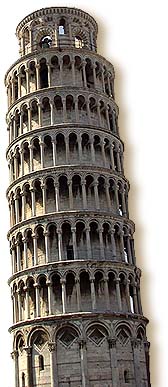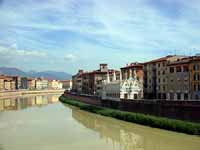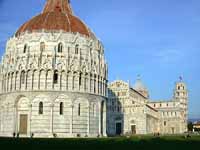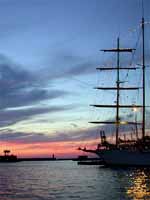27 September, Thursday: Livorno (Leghorn) and Pisa
The tower has been closed to the public since 1990 as engineers work to stop the continuous lean. Evidently, they have been successful and the tower may be re-opened next year. I don't know what parts will be open to the public, but I imagine it would be quite difficult to walk comfortably on any of the six stories or to go up or down the stairs. However, it's an experience I'd love to have.
We toured the Duomo and then left to have a look at other, less touristy parts of Pisa. A few blocks away flowed the Arno River. When I think of the Arno, I think of Florence, not Pisa; but it has to flow to the sea somewhere, so why not through Pisa? It was slow-moving and brown. We stopped for gelato, looked into shops, visited the ATM, checked for messages at an internet shop, even came across an exhibit of 25 drawings by Sergio Staino depicting the story of Pinocchio, who was "born" in Florence in 1881.
After a pizza, we headed back to the Field of Miracles to see more of the sights, such as the Baptistery, topped with a majestic dome. The acoustics are shown off periodically when a security guard joins some singers in chanting; the echoes reply. The Camposanto is an ancient burial ground, its galleries paved with about 600 tombstones. There once were wall frescos, but most were destroyed during Allied artillery shelling in 1944. Workers are trying to put them back together but it may be too great a challenge.
We taxied back to port, passing the Quatro Mori (Four Slaves), also known as the monument to Grand Duke Ferdinand, the last prominent Medici. It commemorates his making Livorno a free city and a haven for anyone suffering religious persecution. The statue of Ferdinand was cast in 1595 and the four bronze Moors, cowering at his feet, were added about thirty years later. Oh, how the San Francisco politicians and political correction police would blather on about this!
Livorno, or Leghorn as the English inexplicably call it, is a port town that was heavily bombed during World War II. Thus, the city is mostly new, known for heavy industry and container shipping. But even before the war, Livorno was hardly a major stop on the Grand Tour. Here is Henry James's description: "It has neither a church worth one's attention, nor a municipal palace, nor a museum, and it may claim the distinction, unique in Italy, of being the city of no pictures."
After dinner, I had beers with two fellows from Hamburg, Germany, who apologized to me because their city had been a base of operations for some of the September 11 terrorists.
| Il Porto di Livorno, Italia |
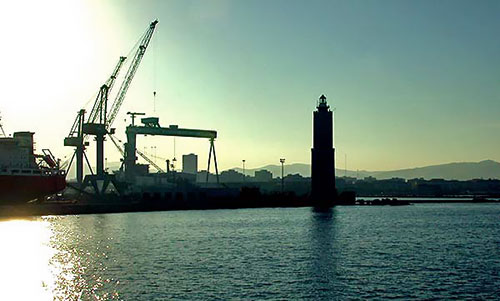
|
|
In the 19th Century, the Mediterranean was a playground for English poets and
other northern Europeans of romantic temperament. British writing of that period frequently mentioned
a mysterious port, Leghorn, which is difficult to find on today's nautical charts.
Leghorn, it turns out, is simply an odd and dated anglicization of Livorno.
Who would have thought to consult a Mediterranean chart for a port named Leghorn?
The poets, Byron and Shelley, lived for a time in Leghorn where Shelley, aged thirty, met his appropriately poetic fate on July 8, 1822. Rumors abound. Some perhaps are true. Shelley sailed from Leghorn on his thirty-foot ketch, Ariel, to return to his home in the Bay of Lerici. Sailing with him were his friend Edward Williams and a sailor who was either Italian or English or perhaps some other nationality. Shelley had never learned to swim despite his fondness for sailing. The Ariel went down, either the victim of a sudden squall or Italian pirates in a felucca. (Given that squalls are not typical of the Mediterranean in July and that the United States Marines were fighting pirates in Tripoli as late as 1805, the felucca legend is not so far-fetched as it seems on first hearing.) The bodies washed ashore near Via Reggio on July 18 where they were discovered by fishermen. After ten days in the sea, the bodies were unrecognizable, but Shelley's friend, Edward Trelawny, found a volume of Sophocles and a volume of Keats' latest poems, Lamia and Isabella and The Eve of Saint Agnes, in the coat pockets of one of the bodies and identified Shelley. Days later, Trelawny organized a cremation of the bodies on the beach with Byron, soldiers and villagers in attendance. During the cremation of Shelley's body, Trelawny took the heart from the fire because it would not burn, and he smashed Shelley's skull, fearing that Byron would salvage it for a drinking cup. While waiting for the pyre to consume Shelley's remains, the easily bored Byron may or may not have swum out to his boat, Bolivar, and back. Trelawny took the heart to Mary Shelley who was either so horrified that she could not accept it or so moved that she carried it with her in a silken shroud everywhere she went for the rest of her life. Shelley's ashes were buried in a Protestant cemetery in Rome where his son William was buried. Keats is interred in the same cemetery. Regarding the skull, Trelawny may have remembered Byron's sly poem, Lines Inscribed Upon a Cup
Formed from a Skull, excerpted here:
Start not - nor deem my spirit fled;
Where once my wit, perchance, hath shone,
George Gordon, Lord Byron, 1808 |
| Duomo and Torre | Tower Detail |
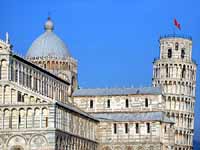
|
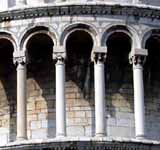
|
| Camposanto | Bas Relief in the Camposanto Floor |

|
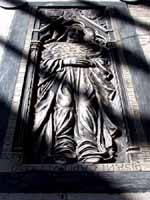
|
| Duomo Interior | Duomo Interior |
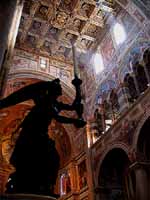
|
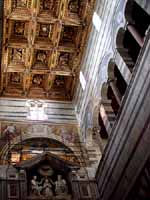
|
